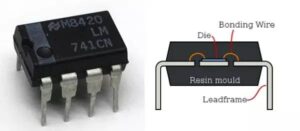An integrated circuit (IC), a term synonymous with microelectronic circuit and microchip, is a pivotal invention in our digital age. Integrated circuits, through their intricate design and microscopic size, serve as the heart of numerous electronic devices we use daily.
Introduction to Integrated Circuits
The journey of the IC begins with the invention of the transistor. This monumental invention replaced vacuum tubes and spearheaded the era of solid-state electronics. The transistor, a semiconductor device, was the brainchild of William Shockley and his team at Bell Laboratories. In essence, it was a revolution in the realm of electronic components, paving the way for miniaturized devices, including transistors and diodes.
The microscopic size of ICs belies their vast capabilities. Inside this small chip, millions of transistors perform complex calculations and operations, undeniably epitomizing the phrase “small but mighty”.
The Makers of Microchips
The birth of the IC chip can be attributed to two brilliant minds – Jack Kilby and Robert Noyce. Jack Kilby, employed by Texas Instruments, was first to patent the invention. Later, Robert Noyce of Fairchild Semiconductor further developed the concept. Both had a shared vision – to construct a complete circuit, including all its components and the semiconductor material (such as silicon) that forms the IC substrate, on a single semiconductor substrate.
The Role of IC Chips
The IC’s importance stems from its ability to perform varied tasks across different electronic components. It could be a microprocessor, directing all operations inside a digital computer or CPU. Or, it could function as a logic circuit, performing calculations and making decisions based on certain criteria. The versatility of ICs is attributable to their unique design, crafted onto a thin, silicon substrate.
Microelectronic circuits have found their place in everything from smartphones and computers to cars and home appliances. Their microscopic size and high-performance capability have made it possible to create highly sophisticated devices that are smaller and more efficient than ever before.
IC Types: Microprocessors and RFICs
Microprocessors are an incredible application of integrated circuits. These logic circuits serve as the ‘brains’ of devices, controlling every function and interaction. Microprocessors are everywhere, from digital computers to game consoles, dictating every move we make in the digital world.
Additionally, the radio-frequency integrated circuit (RFIC) represents another significant type of IC. RFICs are the backbone of wireless communication, enabling devices to send and receive signals. These analog circuits often form the basis of ASICs (Application-Specific Integrated Circuits), built to perform a specific task in devices such as cellphones.
Final Words
In summary, integrated circuits, whether as a microchip or an IC substrate, have become the essence of electronic components. Their invention, thanks to pioneers like Kilby and Noyce, marks a pivotal moment in the history of electronics. With the continuous evolution of semiconductor materials and an unending quest to reduce the size of these miniaturized devices, the future holds unlimited potential for IC technology. As a result, our devices are becoming faster, smaller, and smarter, continually changing how we interact with the world around us.
Truly, ICs demonstrate that big things indeed come in small packages.
